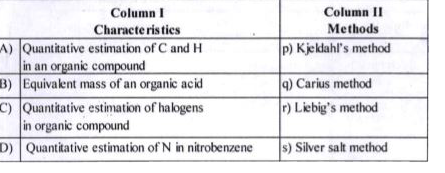Assertion : In organic layer test, Cl2 water is added to the sodium extract, which oxidises which oxidises BrΘandIΘ ions to Br2 and I2, respectively.
Reason : Reduction potential of Cl2 is greater than that of Br2 and I2. Solution in Malayalam
Statement 1 is True, statement 2 is True, Statement 2 is Correct explanation for Statement 1.
Statement 1 is True, Statement 2 is True, Statement 2 is NOT a correct explanation for Statement 1.
Statement 1 is True, Statement 2 is False.
Statement 1 is False, Statement 2 is True.
The correct Answer is:A
Cl2+BrΘ→2ClΘ+Br2, Cl2+IΘ→2ClΘ+I2
Reduction potential E(Cl2/Cl−)>E(Br2/Br−) or El2/l−
Topper's Solved these Questions
- BOOK - BRILLIANT PUBLICATIONCHAPTER - PURIFICATION AND CHARACTERISATION OF ORGANIC COMPOUNDSEXERCISE - LEVEL- III (Linked Comprehension Tyne (Paragraph I))12videos
PURIFICATION AND CHARACTERISATION OF ORGANIC COMPOUNDS
- BOOK - BRILLIANT PUBLICATIONCHAPTER - PURIFICATION AND CHARACTERISATION OF ORGANIC COMPOUNDSEXERCISE - LEVEL- III (Matching Column Type)5videos
PURIFICATION AND CHARACTERISATION OF ORGANIC COMPOUNDS
- BOOK - BRILLIANT PUBLICATIONCHAPTER - p-BLOCK ELEMENTSEXERCISE - LEVEL- III (Linked Comprehension Type) (Paragraph IV )3videos
p-BLOCK ELEMENTS
- BOOK - BRILLIANT PUBLICATIONCHAPTER - REDOX REACTIONSEXERCISE - LEVEL -III50videos
REDOX REACTIONS
Similar Questions
Which species is not present in the Lassaigne's extract? N O 3- C N- C N S Θ S 2 −
01:18View Solutionmatch the following
 03:42View Solution
03:42View SolutionWhich among the following is the strongest oxidising agent?
View SolutionC2O24−+MnO−4H+−−→Mn2++CO2
The number of H+ ions in the balanced equation of the above redox reaction is02:26View SolutionCl_(20 is stronger ………………….. agent then Br_(2) and I_(2) as its reduction potential is ……………………… than that of Br_(2) and I_(2)
View SolutionAsseration: Iodine does not displace Cl2 or Br2 from their chlorides and bromides but displace them from their oxo-salts.
Reason: E∘op of I2>E∘OP of Cl2 or Br205:34View Solution(A) : Boiling a solution containing Cl−,Br− and I− with potassium persulphate, violet and brown vapours appear.
(R ) : Br− and I− are oxidised to Br2 and I2 and Cl− is not oxidised.01:18View Solutionनिम्नलिखित में से कौन-सी अभिक्रियाएँ सम्भाव्य (feasible) हैं। तथा कौन-सी नहीं एवं क्यों?
(i) F2+2NaBR→2NaF+Br2
(ii) Cl2+2NaF→2NaCl+F2
(iii) Br2+2NaC<o2NaBr+Cl2
(iv) I2+2NaC<o2Nal+Cl2
(v) Br2+2Na<o2NaBr+I201:18View SolutionTo an aqueous solution containing I−andBr− ions , I2 and Br2 are added . The products of the reaction would be
View SolutionIdentify, with a reason, the stronger oxidising agent in each of the following pairs. Cl_(2)(g), Br_(2)(l)
View SolutionBond energy of Cl2,Br2andI2 follow the order
View SolutionBond energy of Cl2,Br2andI2 follow the order
04:01View SolutionO_(2),N_(2),Cl_(2),Br_(2),F_(2),I_(2) are hetero diatomic molecules.
02:11View SolutionF_(2),Cl_(2),Br_(2) And I_(2) Of bound energies respectively 155.4,243.6,193.2 And 151.2" KJmol"^(-1) is
04:01View SolutionWhat is the rate of reaction with Cl_(2), Br_(2) and I_(2) with CH_(2) -= CH_(2) .
01:49View SolutionCalculate ΔGΘ and the equilibrium constant for the cell reaction : Cl2+2I−→2Cl−+I2
Given that EΘ(Cl2,Cl−)=1.36V,EΘ(I2I−)=0.536V01:55View Solution

